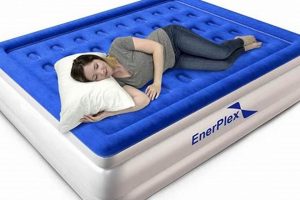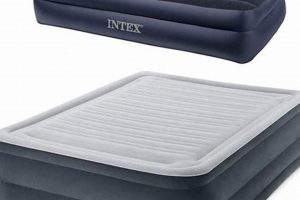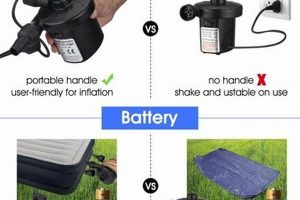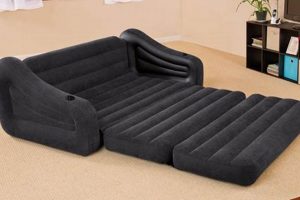Specialized support surfaces designed to alleviate sustained pressure on vulnerable areas of the body are often recommended for individuals at risk of or already exhibiting pressure ulcers. These mattresses utilize air-filled chambers that cyclically inflate and deflate. This alternating pressure redistributes the patient’s weight, minimizing prolonged compression of bony prominences against the mattress surface and promoting improved blood circulation to the skin and underlying tissues.
These devices play a vital role in pressure ulcer prevention and treatment protocols. By dynamically adjusting pressure distribution, they reduce the risk of tissue damage caused by ischemia. Historically, static support surfaces were the standard of care; however, studies have demonstrated the superiority of alternating pressure systems in promoting healing and reducing the incidence of new ulcers, leading to significant improvements in patient outcomes and reduced healthcare costs.
The following sections will delve into the different types of these support surfaces, their mechanisms of action, key features to consider when selecting one, and guidelines for proper usage and maintenance. The information presented aims to provide a comprehensive understanding of these essential tools in pressure ulcer management.
Tips for Optimizing Air Mattress Use for Pressure Ulcer Management
Proper utilization of specialized support surfaces is crucial for maximizing their effectiveness in preventing and treating pressure ulcers. The following guidelines offer essential insights into ensuring optimal performance and patient safety.
Tip 1: Verify Correct Mattress Inflation: Regular monitoring of inflation levels is essential. Insufficient inflation negates the pressure redistribution benefits, while overinflation can create a rigid surface, increasing pressure on bony prominences. Refer to the manufacturer’s guidelines for precise inflation parameters.
Tip 2: Ensure Proper Weight Distribution: The patient’s weight should be evenly distributed across the mattress surface. Avoid positioning that concentrates pressure on specific areas. Consider using pillows or wedges to support bony prominences and promote even weight distribution.
Tip 3: Implement Regular Skin Assessments: Even with specialized support surfaces, diligent skin assessments are paramount. Monitor for signs of redness, blistering, or tissue breakdown, paying particular attention to bony prominences such as the sacrum, heels, and hips. Document findings and report any concerns promptly.
Tip 4: Maintain a Clean and Dry Environment: Moisture and contamination can exacerbate skin breakdown. Regularly clean the mattress surface according to the manufacturer’s instructions, using appropriate disinfectants. Ensure the patient’s skin remains clean and dry to minimize the risk of maceration.
Tip 5: Address Nutritional Deficiencies: Adequate nutrition is essential for tissue repair and wound healing. Consult with a registered dietitian to assess the patient’s nutritional status and address any deficiencies. Ensure the patient receives sufficient protein, vitamins, and minerals to support skin integrity.
Tip 6: Promote Mobility and Repositioning: Encourage frequent repositioning, even on specialized support surfaces. Repositioning helps to relieve pressure and promote blood flow to different areas of the body. Establish a repositioning schedule and adhere to it consistently.
Tip 7: Educate Caregivers and Patients: Thoroughly educate caregivers and patients on the proper use, maintenance, and monitoring of these support surfaces. Ensure they understand the importance of adherence to the established care plan and the need to report any concerns promptly.
Adherence to these recommendations enhances the efficacy of specialized support surfaces and contributes to improved patient outcomes in pressure ulcer prevention and treatment. Consistent implementation of these strategies promotes skin integrity and reduces the risk of complications.
The subsequent section will focus on troubleshooting common issues and identifying when a support surface upgrade may be necessary.
1. Pressure Redistribution
Pressure redistribution is a fundamental principle underlying the efficacy of specialized support surfaces in preventing and treating pressure ulcers. These mattresses are designed to minimize concentrated pressure on bony prominences, thereby improving tissue perfusion and reducing the risk of ischemia-induced tissue damage.
- Alternating Pressure Therapy
Alternating pressure therapy involves cyclical inflation and deflation of air cells within the mattress. This dynamic redistribution of pressure prevents prolonged compression of tissues, allowing for intermittent restoration of blood flow. For instance, a patient lying on their sacrum will experience periods of reduced pressure as the underlying air cells deflate, promoting circulation and preventing ulcer formation. The frequency and duration of these cycles are crucial for optimizing therapeutic benefit.
- Immersion and Envelopment
These mattresses are designed to allow the patient to sink into the surface, effectively distributing weight over a larger area. This immersion, coupled with envelopment around bony prominences, reduces peak pressures at vulnerable sites. A patient with prominent heels, for example, will benefit from a mattress that conforms to the contours of the heels, preventing localized pressure that can lead to tissue breakdown.
- Zoning and Segmentation
Many advanced support surfaces incorporate zoning or segmentation, where different sections of the mattress are independently adjustable to accommodate varying body weights and pressure requirements. For example, a patient with greater weight concentrated in the trunk may benefit from increased support in that area, while lower pressure settings are applied to the lower extremities. This targeted pressure management enhances patient comfort and therapeutic effectiveness.
- Microclimate Management
Pressure redistribution is often coupled with microclimate management features, such as breathable fabrics and moisture-wicking materials. Reducing skin moisture minimizes friction and shear forces, further decreasing the risk of pressure ulcer development. For example, a patient prone to sweating will benefit from a mattress that wicks away moisture, keeping the skin dry and reducing the likelihood of maceration and subsequent tissue damage.
The various facets of pressure redistribution, when effectively implemented in specialized support surfaces, contribute significantly to pressure ulcer prevention and treatment. Selection of the appropriate mattress should be based on a thorough assessment of the patient’s individual needs, risk factors, and clinical presentation to ensure optimal pressure management and improved patient outcomes.
2. Alternating Inflation
Alternating inflation constitutes a core functional component of specialized support surfaces designed for pressure ulcer prevention and treatment. The cyclical inflation and deflation of air cells within the mattress is the mechanism by which pressure is periodically relieved from areas subjected to prolonged weight-bearing. Without alternating inflation, these mattresses would largely function as static support surfaces, lacking the crucial dynamic pressure redistribution capabilities that are paramount in preventing tissue ischemia. The process directly addresses the etiology of pressure ulcers, which form when sustained pressure impedes blood flow to tissues overlying bony prominences.
The clinical impact of alternating inflation is significant. For instance, a patient immobilized due to a spinal cord injury relies heavily on the cyclic changes in pressure facilitated by this mechanism. The consistent periods of pressure relief, however brief, allow for reperfusion of tissues, mitigating the risk of ulcer formation in vulnerable areas like the sacrum and ischial tuberosities. The effectiveness of alternating inflation is further amplified when combined with appropriate patient repositioning and skin care protocols. Moreover, variations in inflation cycle duration and pressure levels provide customizable therapy options, allowing for tailoring the support surface to the patient’s specific needs and risk profile. For example, someone with thin skin might benefit from a shorter cycle or lower pressure than someone with more robust tissues.
In summary, alternating inflation is an indispensable element in the functionality of support surfaces used for pressure ulcer management. Its capacity to dynamically redistribute pressure offers a direct countermeasure to the primary cause of pressure ulcer development. The successful application of alternating pressure therapy, however, requires a comprehensive approach encompassing careful patient assessment, appropriate mattress selection, adherence to manufacturer guidelines, and consistent implementation of preventive skin care measures. Ultimately, the strategic utilization of alternating inflation contributes to improved patient outcomes and reduced healthcare costs associated with pressure ulcer complications.
3. Skin Microclimate
The skin microclimate, referring to the temperature and humidity at the skin’s surface, profoundly influences the risk of pressure ulcer development, particularly for individuals utilizing specialized support surfaces. Maintaining a favorable microclimate is thus a crucial consideration in selecting and managing support surfaces.
- Temperature Regulation
Elevated skin temperature increases metabolic demand and reduces tissue tolerance to pressure. Specialized support surfaces with breathable fabrics or integrated cooling technologies can help regulate skin temperature, preventing overheating and minimizing the risk of tissue breakdown. For instance, mattresses incorporating airflow channels can dissipate heat, thereby reducing the metabolic burden on skin cells and promoting tissue viability.
- Moisture Management
Excessive moisture, whether from perspiration, incontinence, or wound exudate, macerates the skin, weakening its barrier function and increasing its susceptibility to shear and friction injuries. Support surfaces with moisture-wicking materials or integrated air circulation systems can help maintain a dry skin surface, reducing the risk of maceration and subsequent ulcer formation. An example is a mattress cover constructed from a hydrophobic fabric that repels fluids, preventing moisture accumulation and maintaining a healthy skin environment.
- Airflow and Ventilation
Adequate airflow around the skin promotes evaporation and reduces moisture buildup. Support surfaces that incorporate air cells or channels enhance ventilation, facilitating heat dissipation and moisture removal. For example, alternating pressure mattresses inherently provide airflow as air cells inflate and deflate, promoting a drier skin environment.
- Impact on Friction and Shear
A compromised skin microclimate exacerbates the effects of friction and shear forces, key contributors to pressure ulcer development. Dry, intact skin offers more resistance to these forces. However, macerated skin is more prone to injury. By maintaining an optimal microclimate, specialized support surfaces help minimize the damaging effects of friction and shear, further reducing the risk of pressure ulcers. Patients who perspire heavily but also have limited ability to reposition are particularly susceptible, and their support surfaces require specific attention to microclimate control.
In essence, the skin microclimate serves as a critical interface between the patient and the support surface. Effective management of temperature and moisture, facilitated by appropriate support surface selection and usage, enhances the protective capabilities of the skin and reduces the likelihood of pressure ulcer development. These considerations highlight the importance of evaluating the microclimate properties of these systems and how such properties might align with unique patient needs and risk factors.
4. Moisture Control
Moisture control plays a critical role in the prevention and management of pressure sores, particularly when utilizing specialized support surfaces. Excess moisture, stemming from perspiration, incontinence, wound exudate, or environmental humidity, compromises the integrity of the skin and increases its susceptibility to damage.
- Maceration and Skin Integrity
Prolonged exposure to moisture macerates the stratum corneum, the outermost layer of the epidermis. This process weakens the skin’s barrier function, rendering it more vulnerable to friction, shear, and pressure. In the context of specialized support surfaces, such as these devices, maceration can significantly increase the risk of pressure ulcer development, especially in areas subjected to prolonged pressure. For example, a patient with urinary incontinence lying on such a device without proper moisture management will experience increased skin breakdown in the sacral region.
- Bacterial Growth and Infection
A moist environment fosters bacterial growth, increasing the risk of skin infections. Compromised skin, due to maceration or existing pressure sores, provides a portal of entry for pathogens. Specialized support surfaces can exacerbate this risk if they trap moisture against the skin. This scenario emphasizes the need for mattresses with moisture-wicking properties and effective ventilation to minimize bacterial proliferation and reduce the incidence of infection.
- Material Properties and Design
Specialized support surfaces vary in their ability to manage moisture. Materials with poor breathability can trap moisture, while those with moisture-wicking properties help maintain a drier skin environment. Design features such as air channels and waterproof but breathable covers further enhance moisture control. For instance, a support surface constructed with a waterproof polyurethane cover that allows water vapor transmiss
ion helps prevent moisture accumulation while protecting the mattress core from contamination. - Clinical Practices and Protocols
Effective moisture control requires not only appropriate support surface selection but also diligent clinical practices. Regular skin assessments, proper hygiene, the use of absorbent pads, and frequent linen changes are essential components of a comprehensive moisture management strategy. A patient on such a surface should have their skin assessed regularly for signs of maceration and appropriate interventions, such as barrier creams or moisture-wicking dressings, implemented as needed.
The effective implementation of moisture control measures, in conjunction with the use of specialized support surfaces, significantly reduces the risk of pressure sore development and promotes healing of existing ulcers. Prioritizing moisture management through appropriate product selection and adherence to established clinical protocols is crucial for optimizing patient outcomes and minimizing the complications associated with compromised skin integrity.
5. Patient Comfort
Patient comfort is an indispensable consideration in the effective utilization of specialized support surfaces, including air mattresses, for pressure sore prevention and treatment. While therapeutic efficacy is paramount, a patient’s experience directly influences adherence to prescribed protocols and, consequently, overall outcomes.
- Noise Levels and Sleep Quality
The operational noise generated by air mattress pumps can disrupt sleep, negatively impacting healing and overall well-being. Excessive noise contributes to anxiety and agitation, hindering the patient’s ability to rest comfortably. For instance, a noisy pump can prevent a patient from achieving restorative sleep, potentially delaying wound healing. Modern air mattresses often incorporate noise-dampening technology to mitigate this issue.
- Surface Stability and Movement
Excessive motion or instability on the mattress surface can induce feelings of insecurity and discomfort. Some air mattresses may exhibit a “wavy” sensation, particularly when the patient shifts position, which can be unsettling. Therefore, mattress designs incorporating features that minimize motion transfer are crucial for enhancing patient comfort. For example, zoned air chambers or foam perimeters provide greater stability and reduce motion-induced anxiety.
- Temperature Regulation and Breathability
The materials used in air mattress construction significantly impact temperature regulation and breathability. Non-breathable surfaces can trap heat and moisture, leading to skin irritation and discomfort. Conversely, mattresses with breathable covers and air circulation features promote a cooler, drier microclimate, enhancing comfort and reducing the risk of skin breakdown. An example is a mattress with a cover made from a moisture-wicking fabric that allows for airflow, thereby preventing the buildup of heat and perspiration.
- Customization and Adjustability
The ability to customize mattress settings to individual patient needs and preferences is essential for optimizing comfort. Adjustable pressure settings allow for tailoring the support surface to the patient’s weight, body contours, and specific pressure relief requirements. This level of personalization not only enhances comfort but also promotes effective pressure redistribution. For example, a patient with bony prominences may require lower pressure settings in those areas to minimize discomfort and prevent tissue damage.
The correlation between patient comfort and the therapeutic effectiveness of air mattresses cannot be overstated. Addressing factors such as noise, stability, temperature regulation, and adjustability directly impacts the patient’s experience and adherence to prescribed care. Ultimately, a comfortable and well-suited air mattress fosters improved patient outcomes and enhances the overall quality of care.
6. Cleanliness Protocol
The effectiveness of specialized support surfaces in mitigating pressure ulcer risk is inextricably linked to adherence to stringent cleanliness protocols. These mattresses, designed to redistribute pressure and improve circulation, can inadvertently become reservoirs for microorganisms if not properly maintained. A lapse in cleanliness undermines the therapeutic benefits of the device and introduces a significant infection risk, particularly for vulnerable patients with compromised skin integrity. For instance, if bodily fluids contaminate the surface and are not promptly removed, bacteria can proliferate, potentially leading to localized skin infections or systemic complications. In healthcare settings, neglecting established cleaning procedures has resulted in outbreaks of hospital-acquired infections directly traced to contaminated medical equipment. Therefore, the implementation and consistent execution of a comprehensive cleanliness protocol are not merely ancillary considerations but essential components of safe and effective pressure ulcer management when employing such devices.
Specific protocols encompass several key elements: regular inspection of the mattress surface for visible soiling or damage, prompt removal of spills or contaminants using appropriate cleaning agents recommended by the manufacturer, and periodic disinfection of the entire surface following a standardized procedure. The choice of cleaning agents is crucial; harsh chemicals can degrade the mattress material, while ineffective disinfectants fail to eliminate pathogens. In practice, this often involves a two-step process: cleaning with a mild detergent to remove organic matter, followed by disinfection with a hospital-grade disinfectant proven effective against common nosocomial pathogens. Furthermore, proper ventilation during and after cleaning is essential to ensure complete drying and prevent moisture accumulation, which can promote microbial growth. Records of cleaning and disinfection activities should be maintained to ensure accountability and facilitate monitoring of compliance with established protocols.
In conclusion, the potential benefits of specialized support surfaces in pressure ulcer prevention and treatment are contingent upon the consistent application of rigorous cleanliness protocols. Compromised hygiene not only negates the intended therapeutic effects but also introduces a significant risk of infection and related complications. Prioritizing and enforcing adherence to established cleaning and disinfection procedures is a fundamental aspect of patient safety and represents an indispensable element in the holistic management of pressure ulcer risk when using these mattresses.
7. Support Surface Selection
Appropriate support surface selection is critical in mitigating the risk and severity of pressure sores, often necessitating the use of specialized mattresses, including air mattresses. The choice of support surface should be guided by a comprehensive patient assessment, considering individual risk factors, existing skin conditions, and overall clinical needs. Inadequate selection undermines preventi
ve efforts and may exacerbate existing tissue damage.
- Risk Assessment Tools
Standardized risk assessment tools, such as the Braden Scale, provide a structured framework for evaluating a patient’s susceptibility to pressure sore development. These tools consider factors such as mobility, sensory perception, moisture exposure, nutritional status, and friction/shear. The cumulative score informs the level of intervention required, potentially indicating the need for an air mattress to redistribute pressure and minimize tissue stress. For instance, a patient with limited mobility and impaired sensory perception would likely benefit from an air mattress to compensate for their inability to independently relieve pressure.
- Patient-Specific Factors
Individual patient characteristics significantly influence support surface selection. Body weight, body mass index (BMI), skin integrity, and presence of comorbidities all warrant consideration. An obese patient, for example, requires a support surface with a higher weight capacity and enhanced pressure redistribution capabilities to prevent tissue compression. Similarly, a patient with fragile skin or pre-existing pressure sores necessitates a mattress with advanced microclimate control to minimize moisture and friction. The clinical picture presented dictates device parameters.
- Mattress Technology and Features
Various air mattress technologies offer distinct advantages. Alternating pressure mattresses cyclically inflate and deflate air cells to redistribute pressure, while low air loss mattresses incorporate small perforations to regulate skin microclimate by minimizing moisture. The selection of technology should align with the patient’s specific needs. An alternating pressure mattress may be indicated for a patient at high risk of pressure sore development due to immobility, whereas a low air loss mattress may be preferable for a patient with excessive perspiration or incontinence. Hybrid systems combine alternating pressure and low air loss to deliver multifaceted prevention.
- Budgetary Considerations
Resource constraints can influence support surface selection. While advanced air mattresses offer superior pressure redistribution and microclimate control, their cost may limit their accessibility. Healthcare providers must balance the clinical needs of the patient with the available resources, exploring cost-effective alternatives when appropriate. Renting devices or procuring refurbished equipment should be considered to balance budget considerations with patient care needs. A cost-benefit analysis should be conducted to ensure that the chosen support surface provides the optimal value within the available budgetary constraints.
In summary, proper support surface selection necessitates a meticulous assessment of individual risk factors, a thorough understanding of available mattress technologies, and a pragmatic consideration of budgetary constraints. Employing risk assessment tools in conjunction with clinical judgment allows for informed decision-making, optimizing patient outcomes and minimizing the incidence of pressure sores. The long-term goal of such decision-making should be preventing the onset of pressure sores which can be highly treatment resistance and reduce the quality of life of a patient.
Frequently Asked Questions
This section addresses common inquiries regarding specialized support surfaces intended for pressure sore prevention and treatment, providing concise and factual information.
Question 1: What distinguishes an air mattress designed for pressure sores from a standard air mattress?
Air mattresses engineered for pressure sore management incorporate features such as alternating pressure, low air loss, and zoned support to actively redistribute weight and manage skin microclimate, elements generally absent in standard recreational air mattresses.
Question 2: How does alternating pressure reduce the risk of pressure sore formation?
Alternating pressure cyclically inflates and deflates air cells, periodically relieving pressure from bony prominences and promoting blood flow to tissues at risk of ischemia. A standard air mattress would provide constant pressure.
Question 3: Are specialized air mattresses suitable for all patients at risk of pressure sores?
The appropriateness of an air mattress depends on a comprehensive patient assessment, including risk factors, body weight, skin integrity, and individual needs. Certain conditions may contraindicate their use; consultation with a healthcare professional is essential.
Question 4: What role does moisture control play in the effectiveness of these mattresses?
Moisture control is vital for maintaining skin integrity and preventing maceration. Air mattresses with moisture-wicking covers or low air loss features help regulate skin microclimate and reduce the risk of tissue breakdown.
Question 5: How frequently should an air mattress for pressure sore prevention be cleaned?
Cleaning frequency depends on usage and manufacturer guidelines. Regular cleaning with appropriate disinfectants is crucial to prevent bacterial growth and maintain a hygienic surface. More frequent cleaning may be warranted in cases of incontinence or wound drainage.
Question 6: Can an air mattress completely eliminate the need for repositioning?
While air mattresses aid in pressure redistribution, they do not replace the need for regular repositioning. Periodic repositioning is essential to relieve pressure on different areas of the body and promote optimal circulation.
Effective pressure sore management necessitates a holistic approach. These devices are only a part of the greater solution.
The next article section delves into the economic considerations of investing in air mattresses for pressure sore prevention.
Conclusion
This exploration has underscored the critical role of air mattress for pressure sores in the comprehensive management of pressure ulcers. These specialized support surfaces, with their capacity for pressure redistribution, microclimate control, and customizable features, offer a significant advantage in preventing tissue breakdown and promoting healing. However, the selection, implementation, and maintenance of these mattresses require meticulous attention to detail, informed clinical judgment, and unwavering adherence to established protocols.
The continued refinement of air mattress for pressure sores technology, coupled with ongoing research into optimal usage strategies, holds promise for further reducing the incidence and severity of pressure ulcers, improving patient outcomes, and alleviating the burden on healthcare systems. A proactive and evidence-based approach to support surface selection and utilization remains paramount in the pursuit of optimal patient care and pressure ulcer prevention.







